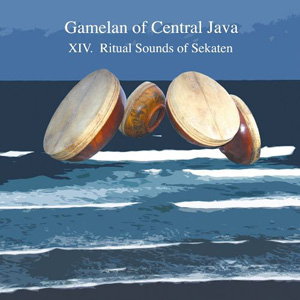 Ritual Sounds of Sekaten is a pendant to Volume II in the series Gamelan of Central Java, presenting three more examples of the music played for the Islamic religious festival of Sekaten in Java. The first two tracks are the same piece filtered through the performance traditions of Yogyakarta and Surakarta, the two main centers of classical Javanese music.
Ritual Sounds of Sekaten is a pendant to Volume II in the series Gamelan of Central Java, presenting three more examples of the music played for the Islamic religious festival of Sekaten in Java. The first two tracks are the same piece filtered through the performance traditions of Yogyakarta and Surakarta, the two main centers of classical Javanese music.
The first track, Gendhing Sekaten Rangkung, is performed by the Gamelan Sekati Guntur Madu of Kraton Surakarta. The opening section is lean, understated, almost random in feeling. It’s only as the piece develops that we begin to discern the underlying structures and rhythms. It’s a slow build that suddenly takes off into a crescendo both in volume and rhythm that resolves itself into a stately finish.
The second version of this piece, from Gamelan Sekati Guntur Madu of Kraton Yogyakarta, begins in a style that seems, if anything, even more spare and random, in a free tempo, although gradually the sense of dialogue becomes more apparent. (The style on both performances is one called imbal, two instruments playing alternately, one on the beat, the other off the beat.) The Yogyakarta version is almost twice as long as the Surakarta performance, and consequently seems to develop a little added complexity as it progresses, especially at the crescendo, which adds intensity to the stateliness. Both remind me very much of contemporary American music, in which silence plays as large a role as sound — there’s a strongly sculptural feel to this work.
The final selection, Bawa and Gendhing Terbang (Rebama), was performed at Surakarta. This is a full gamelan, with chorus, and partakes of the same stateliness as the two previous performances, although much more apprehendible at the beginning. This is full-bore ritual, without the seemingly random free tempo of the Gendhing Skeaten Rangkung. There’s quite an insistent, driving rhythm underneath this piece, while the vocal parts provide a flowing line, accented by the gongs and bells, which bring in a slower, measured beat that adds another layer to the richness.
Accompanying the disc is a very informative essay on the influence of Sufi Islam on the music of Java, or perhaps I mean not so much influence as recognition of mutual strengths. There is also an essay by composer Philip Corner, an impressionist rumination on gamelan and how music is made.
This volume in the series offers not only additional examples of Javanese ritual music, but the chance to see the wide range of variation in approaches and interpretation possible in a set of traditions that seems to be anything but rigid or hidebound.
And besides, the music is completely captivating.
The final volume in this series is reviewed here.
(Felmay, 2010)
